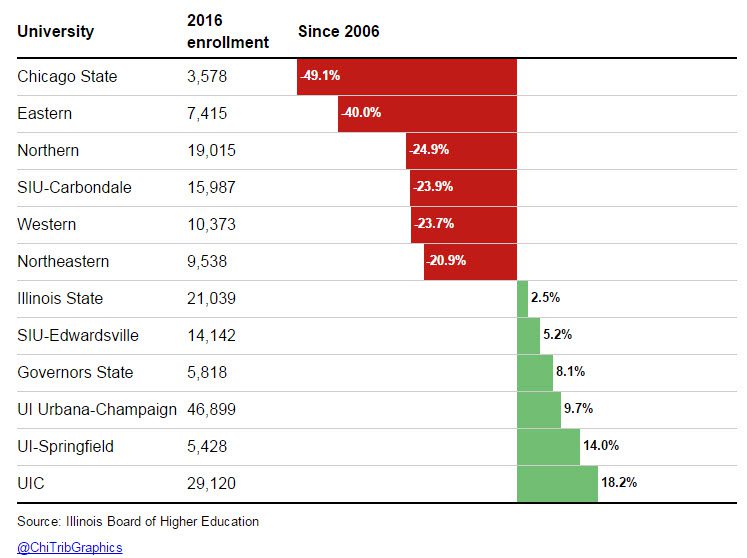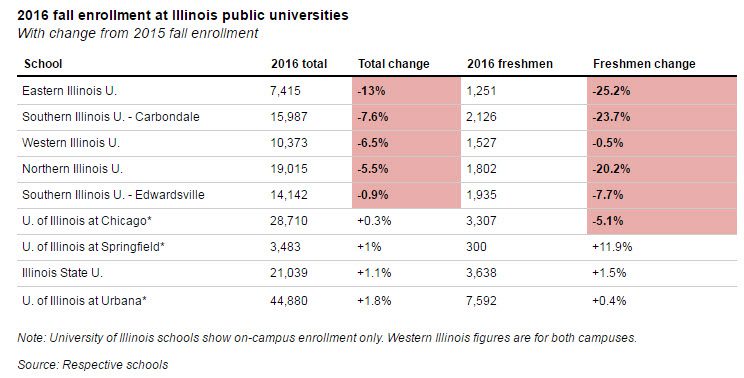![University of Illinois at Urbana-Champaign, Main Library. https://commons.wikimedia.org/wiki/File%3AMainLibrary_Urbana_Illinois_4582.jpg; By Dori (Own work) [GFDL (http://www.gnu.org/copyleft/fdl.html) or CC BY-SA 3.0 us (http://creativecommons.org/licenses/by-sa/3.0/us/deed.en)], via Wikimedia Commons](https://wp-media.patheos.com/blogs/sites/533/2017/06/800px-MainLibrary_Urbana_Illinois_4582.jpg)
Here’s a post that I started writing back in April. You see, back at the time, the Chicago Tribune had a stunning graph in its lead Sunday editorial, “Governor, start fixing higher ed in Illinois: How to pour more spending into classrooms and labs.”

It’s generally known that Chicago State, due to massive mismanagement, has had stunning drops in enrollment. But a 40% drop at Eastern Illinois? a 25% at Northern, and nearly as much at SIU-Carbondale and Western? Holy moly!
Here’s another chart from the fall that breaks down freshmen enrollment changes in 2016.

This was not a surprise — and even my own son says, “Mom, I don’t want to go to a state school in Illinois for college because I’m afraid that, with the budget battle, they’ll cut off funding.”
At the same time, the total enrollment of all students in Illinois (including community colleges and private colleges) has been stable from 2005 to 2015, according to the state, but I was unable to find information on the change in numbers of college-aged students during that time — that is, to find out how many students went out of state, vs. out-of-state students coming into Illinois.
Another article reports that at Northern Illinois University, enrollment peaked in 2006, well before the current budget crisis.
And apparently Southern Illinois has had 20+ years of declining enrollment (the article is undated, but refers to a bomb threat indictment that occurred in the fall of 2014 at the latest, that is, before Rauner was elected and the current budget battle began.)
And, a day after this Tribune editorial, the reports came out that New York had established free tuition in the SUNY system for everyone in families with household income less than $100,000 (increasing to $125,000). (See this UPI report, for instance.)
My first reaction was that this was nuts: it would result in all sorts of unintended effects. Schools could feel more comfortable boosting tuition with the rationale that only wealthy students are paying. Families at the margin (since there didn’t seem to be any phase out) would get hammered for earning $126,000. And the requirement that students must stay in state after graduation seemed unnecessarily punitive; New York is hardly hurting for talent, but students entering professions centered elsewhere would lose out. And the program could easily induce more students to (want to) stay in-state or attend a public school, either causing significant enrollment increases, limiting the number of out of state students accepted, or leading to disgruntled students unable to gain admission as each tier of college becomes more selective than previously. And if enrollment climbs, or if out of state students decrease, that impacts the budget.
But in looking at the system in New York, I was surprised to learn that (a) the tuition was already fairly low ($6k-ish) for in-state students, and that (b) the entire system is managed centrally, with the legislature controlling not just state spending but also tuition. And, in fact, that was the central recommendation in the above Tribune editorial:
Governor, don’t waste this crisis. Create a master plan to replace Illinois’ balkanized structure of higher ed. There’s a strong model across the border: Wisconsin’s single, centrally-overseen and multitiered system of 26 campuses offering 250 majors. New York and some other states have comparable systems. Illinois students, too, could prosper under a system that deploys resources effectively and sets high expectations for campuses statewide. Unifying schools, of course, would anger politicians who defend fiefdoms in Carbondale or Charleston or Chicago.
Illinois once had a more centralized system that delivered excellent results for students. But in 1995, the General Assembly dismantled what was known as the “system of systems.” One reason: more “local control.” Of state universities? A bigger reason: Some pols were miffed that their alma maters didn’t have separate governing boards like the U. of I.’s. . . .
But the higher ed cash trough is dry. Southern Illinois University President Randy Dunn warned lawmakers last month that “As we go into this next phase of the crisis, with no budget in sight, SIU and many other universities are going to be forced to dismantle and remove units of university operations. If we don’t find a way forward, we have a lot of universities getting ready to walk off the cliff.”
And, indeed, if you look at the enrollment trends in the first table, there’s wasted money there — it costs money to maintain buildings, regardless of whether they’re used at capacity. It cost money to add capacity to growing universities, money that’s wasted if those students could be attending other universities.
Now, as I said, this was two months ago. And the budgetary crisis has gotten worse, not better — Illinois is facing junk bond status, and, in doing that google search, I learned that Illinois regional universities have been at junk bond status since April.
It’s appalling. And, yes, while we stay, and watch our taxes go up over and over again, we certainly expect our kids to leave.
*H-E-double-hockeysticks, of course.
Image: University of Illinois at Urbana-Champaign, Main Library. https://commons.wikimedia.org/wiki/File%3AMainLibrary_Urbana_Illinois_4582.jpg; By Dori (Own work) [GFDL (http://www.gnu.org/copyleft/fdl.html) or CC BY-SA 3.0 us (http://creativecommons.org/licenses/by-sa/3.0/us/deed.en)], via Wikimedia Commons










